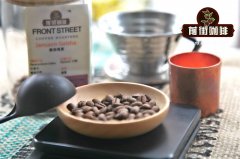What's the flavor of Ethiopian coffee? a brief introduction to the types of individual coffee.

Professional coffee knowledge exchange More coffee bean information Please pay attention to coffee workshop (Weixin Official Accounts cafe_style)
Front Street-Ethiopian Coffee, Single Coffee Variety Introduction
Ethiopia's geographical environment is very suitable for coffee growth. Coffee is mainly grown in the southern highlands between 1100 and 2300 meters above sea level. The main coffee producing areas are Harar, Limu, Djimma, Sidamo, Kaffa, Yergacheffe and Wellega. The soil in these areas is well drained, slightly acidic, and red and loose.
In Ethiopia, both washing and solarization are common. In solarization, farmers place coffee cherries on a flat surface and use the sun to dry them. This process, which usually takes two to six weeks, smoothes the beans and turns them over to dry them evenly, separating the seeds from the cherries. Typical washed Ethiopian coffee exudes elegant flavor, delicate floral and citrus flavor, smooth taste, flavor has strong regional characteristics. Sun-baked coffee has a more rounded, fruity flavor…good sun-baked coffee not only retains the fresh citric acid and floral flavor, but also adds sweetness and body compared to washed coffee.
Single coffee type
Arabica is a representative variety of Ethiopia, which is also produced in South Africa, Africa and Asian countries, accounting for 70~75% of the world's coffee production. Arabica is less resistant to pests and diseases, so highland areas are more suitable for cultivation, especially Arabica beans grown at heights above 1500 meters. Such efforts to produce good quality, with a balanced taste and aroma, can be certified as a premium coffee bean, mainly used in single-serve coffee or fine coffee.
Typica
Tibica is the original species of all Arabica varieties. Tibika is said to have originated in southern Sudan, flourished in Ethiopia, and was finally cultivated for commercial production in Yemen around the 7th century AD. Tibica was brought to the East Indies by the Dutch and was the first coffee variety to arrive in the West Indies, where Gabriel Deckley planted it in French Martinique in 1720.
The ripe fruit of Tibica is red. This variety has relatively low yield and poor disease resistance, but its excellent cup test quality still makes it popular all over the world.
Bourbon
Bourbon is the product of a genetic mutation in the native Tibica species on Reunion Island and is the paternal and even grandparent line of many popular Latin American coffee species, including Kadura, Kaduai, Pakas, New World, and others
species. Bourbon, still popular in Latin America today, traveled further afield to Africa, settling in Rwanda and Burundi. The ripe fruit of Bourbon is mostly red, but there are yellow or orange varieties. Bourbon yields about 20% to 30% more than Tibica; although the flavor is slightly sweeter and sometimes better balanced, the two varieties of coffee are generally very similar.
Catimor
Khatim is a cross between Khadura and Timor-not to be confused with Khadura and Kaduai. This highly resistant plant has the ability to resist coffee leaf rust and was widely cultivated in Latin American countries in the 1980s. Unfortunately, because Timor (also known as Arabusta) is the product of a natural cross between Tibica Arabica and Robusta, although the latter confers disease resistance, the delicate taste of Arabica is lost.
Catuai
Kaduai was bred in Brazil in the 1950s. It is a hybrid of Kadura and New World, with strong disease resistance and high yield. Similar to Kadura, the ripe fruit of Kaduai is naturally divided into red and yellow (I personally prefer the former). Carduai is known for its intense acidity and is a common variety in most Central American countries.
Caturra (English)
In the 1930s, a gene mutation in bourbon was discovered near the Brazilian city of Kadulla, and it was named Kadulla. Kadura is a high-yield, compact plant that is easy to pick, but if grown at lower altitudes, this trait becomes its own worst enemy-coffee becomes so light that the weight of the fruit itself can crush the plant. If grown at high altitudes (above 1200 meters), Kadura's coffee quality and yield are more guaranteed. Kadura is a common name in the coffee belt of Central America.
See varieties.
English Geisha
The slightly lanky fruit and leaves of Guixia are genetic mutants of Tibika and are said to be native to Guixia, a small town in southwestern Ethiopia. In the 1930s, rose seeds were shipped to Tanzania, and in the 1950s to Costa Rica. These two countries are the only significant growers of Rosa outside Panama-although Panama is the best spokesperson for Rosa.
In Panama's high-altitude growing regions, Jamaica Blue Mountain coffee proved itself to be the undisputed coffee variety after its tropical flavor, citrus and tea characteristics. Everyone loves good coffee and sincerely hopes that Guixia can go to other countries.
Pacamara (English name)
Developed by El Salvador in the late 1950s, Pacamara is a hybrid of Pacas and Malagojipe, and is in high demand today. Similar to the marago gipe, it is large-usually twice the size of a standard bourbon bean-but it produces only modest amounts. Pakamala is widely praised for its clean acidity and fresh floral fragrance, and the higher the altitude, the better.
SL–28
SL-28 's "SL" is an acronym for Scott Lab, a technology company hired by the Kenyan government since the 1930s to identify local coffee varieties that are most suitable for large-scale cultivation. SL-28 has become the benchmark variety in several planting areas of Kenya because of its strong blackcurrant flavor. SL-28 should be planted in high altitude areas.
SL-34
SL-34 is slightly lower in quality than its sister SL-28 (but by no means bad), but also has outstanding acidity and berry flavor. SL-28,SL-34 performs better at low altitudes (although it has a larger number), and it is also more resistant to torrential rains if planted at high altitudes, so people prefer to grow at high altitudes. However, both SL-28 and SL-34 are easily affected by coffee leaf rust.
Gift of knowledge: Arabica coffee plants bear more subtle flavors, its varieties are widely distributed and well-defined, and the appearance and style of the coffee are distinctive.
END
Important Notice :
前街咖啡 FrontStreet Coffee has moved to new addredd:
FrontStreet Coffee Address: 315,Donghua East Road,GuangZhou
Tel:020 38364473
- Prev

What kind of coffee is Ethiopia? introduction to the origin and variety of coffee beans.
Professional coffee knowledge exchange more coffee bean information please follow the coffee workshop (Wechat official account cafe_style) front street-Ethiopian coffee beans, coffee varieties and producing areas brief introduction to most Ethiopian varieties will be named after this name, small farmers from various forests and their own back garden picked various varieties of coffee and sent to the cooperative for centralized processing, varieties can be said to be
- Next

Which is good for ethiopia coffee beans? share the parameters of washing and brewing with Xuefei.
Professional coffee knowledge exchange more coffee bean information please follow the coffee workshop (Wechat official account cafe_style) front street-Ethiopia Yega Xuefei Coffee introduction is located in Ethiopia, a small town, elevation of 1700-2100 meters, can be said to be one of the highest coffee producing areas in the world, in other words, the Yega Xuefei producing area originally belonged to the Sidamo producing area
Related
- Beginners will see the "Coffee pull flower" guide!
- What is the difference between ice blog purified milk and ordinary milk coffee?
- Why is the Philippines the largest producer of crops in Liberia?
- For coffee extraction, should the fine powder be retained?
- How does extracted espresso fill pressed powder? How much strength does it take to press the powder?
- How to make jasmine cold extract coffee? Is the jasmine + latte good?
- Will this little toy really make the coffee taste better? How does Lily Drip affect coffee extraction?
- Will the action of slapping the filter cup also affect coffee extraction?
- What's the difference between powder-to-water ratio and powder-to-liquid ratio?
- What is the Ethiopian local species? What does it have to do with Heirloom native species?

